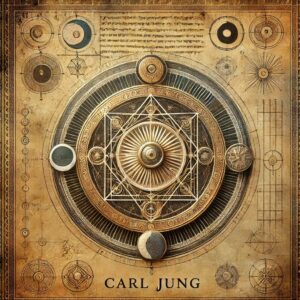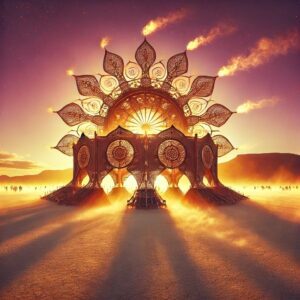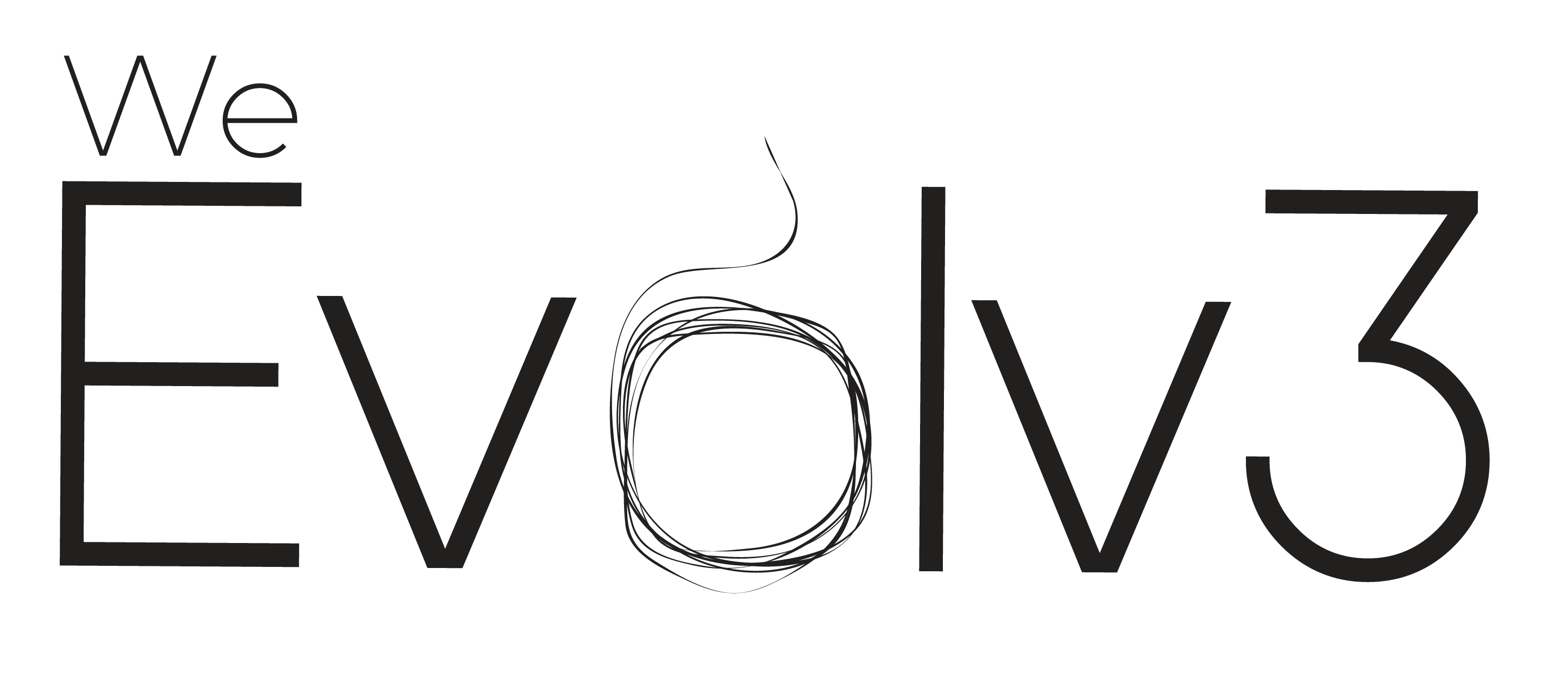Jung’s Collective Unconscious and Archetypes
Let’s start with something that’ll blow your mind: Carl Jung believed that buried deep within your psyche is a treasure trove of memories, patterns, and symbols that you didn’t just inherit from your parents or your personal experiences – but from the entirety of human history. Yeah, you heard that right. Jung called this the collective unconscious. It’s like a shared hard drive for humanity, where all the archetypes; the fundamental symbols and themes of human experience are stored.
Now, these archetypes are a bit like the characters in a universal play, constantly showing up in myths, dreams, and even your daily life. Think of the wise old man, the hero, the mother, and the shadow – these aren’t just characters we see in movies; they’re symbols that reflect something deep within all of us. Jung believed that these archetypes guide our behaviors and influence the way we experience the world, often without us even realising it.
Here’s the kicker: the collective unconscious isn’t something you can just tap into whenever you feel like it. It’s not like a Google search for your brain. It’s more like an ocean that you occasionally dip into, usually through dreams, art, or those deep moments of introspection that hit you at 3 AM when you’re questioning your life choices.
But here’s the cool part: you don’t have to wait for 3 AM existential dread to access this ocean. Practices like Vedic meditation and certain types of breathwork can serve as powerful tools to help you dip into these deeper layers of the unconscious. These practices calm the mind, allowing you to bypass the noisy chatter of everyday thoughts and connect more directly with those ancient, archetypal symbols and insights that lie beneath the surface. In a way, they’re like a guided tour of the collective unconscious, helping you explore and integrate the depths of your psyche in a more intentional, structured way.
So, whether through meditation, breathwork, or even those random, deep thoughts that come when you least expect them, tapping into the collective unconscious is about exploring that vast, shared ocean of human experience. And while each person’s conscious mind might be different, Jung believed that we all share this collective ocean of memories and symbolsan ancient part of our psyche that connects us across cultures and history.
The idea is that these archetypes shape the narratives of our lives. They’re like the blueprint of the human experience, and whether you’re aware of it or not, they’re influencing the way you see the world, the way you interact with others, and even the way you process your own life story.
In short, Jung’s collective unconscious is the psychological version of the cloud, storing all the data that makes us human, ready to be accessed whenever our conscious minds are willing, or vulnerable enough, to take the plunge, with meditation and breathwork as your secret key to deeper access.
Morphic Resonance Explained
Alright, let’s switch gears and dive into some trippy science. Imagine for a moment that all living things, plants, animals, humans are connected by invisible fields that carry memories. This isn’t some sci-fi plot; it’s the essence of Morphic Resonance, a theory proposed by Rupert Sheldrake. According to Sheldrake, these “morphic fields” are responsible for the shapes and behaviors of living systems, and they’re built up over time by the repetition of particular actions or patterns.
So, what does this actually mean? Let’s break it down.
Morphic Resonance suggests that when something happens, like a crystal forming or a habit being learned, it becomes easier for the same thing to happen again, not just in the same place but anywhere in the world. The information or memory of that event isn’t stored in a physical form like DNA or brain cells, but in these morphic fields, which transcend space and time. Essentially, the past influences the present not just through physical means, but through these fields of information.
Picture this: you’re learning to play the guitar, and it’s tough going at first. But according to Morphic Resonance, every time someone else successfully learns that same chord, it becomes just a tiny bit easier for you to learn it too. Why? Because their learning experience is stored in a morphic field that you’re now tapping into.
Now, before you start wondering why we’re not all guitar virtuosos yet, keep in mind that Sheldrake’s theory is still pretty controversial. Mainstream science hasn’t exactly embraced it with open arms. But for those open to exploring beyond the conventional, it offers a fascinating way to think about how learning, evolution, and behavior might work on a broader, interconnected scale.
And here’s where things get really interesting: these morphic fields aren’t just about skills or physical forms. They could also apply to the way we think, feel, and even how societies develop. If you’ve ever felt like there’s an invisible influence shaping your thoughts or actions, Morphic Resonance might just be the explanation that fits.
So, while it might sound like a wild concept, Morphic Resonance opens up the possibility that we’re all much more connected than we think – both to each other and to the past. It’s like we’re all part of this vast web of memory and influence, constantly shaping and being shaped by the world around us.
Now, let’s see how this ties into Carl Jung’s work, and why he might have been intrigued by Sheldrake’s ideas.
The Intersection of Ideas
Now, let’s start connecting the dots between Carl Jung’s theories and Rupert Sheldrake’s Morphic Resonance. On the surface, these might seem like two very different ideas, one rooted in depth psychology, the other in a speculative extension of biology – but when you dig deeper, you start to see how they could be part of the same grand narrative.
First up, Jung’s collective unconscious and Sheldrake’s morphic fields both suggest that there’s more to our experience than what’s visible or directly measurable. Jung believed that the collective unconscious holds the accumulated wisdom of our species, accessible through dreams, myths, and symbols. Similarly, Sheldrake’s morphic fields are said to store the memory of behaviors, forms, and actions, which then influence how similar patterns unfold in the present.
What’s the common thread here? Both theories propose a kind of non-local influence, something that transcends the boundaries of individual minds or organisms. For Jung, this influence manifests as archetypes and shared symbols, while for Sheldrake, it’s the resonance of past patterns affecting the present. In other words, both ideas suggest that we’re not just isolated beings but are deeply connected to each other and to the past in ways that go beyond physical interactions.
Now, think about this: if Jung’s collective unconscious is like a vast, shared memory bank of human experience, then Sheldrake’s morphic fields could be seen as the mechanism by which this memory is transmitted and reinforced. Every time someone taps into an archetype or learns a new behavior, it strengthens the corresponding morphic field, making it easier for others to do the same.
This intersection offers a fascinating possibility: that Jung’s archetypes and the patterns we see in human culture might not just be psychological phenomena but could also be influenced by these morphic fields. It’s like saying that the more people engage with a particular archetype or symbol, the stronger and more accessible it becomes for everyone else.
For instance, the archetype of the hero might be universally recognised not just because it’s embedded in our collective unconscious but because it resonates through a morphic field that’s been built up over centuries of storytelling, from ancient myths to modern movies. Every time a new hero’s journey is told, it doesn’t just add to our cultural lore; it reinforces that archetype in the morphic field, making it more potent and easier for future generations to connect with.
In this way, Morphic Resonance and the collective unconscious could be seen as two sides of the same coin – one focusing on the psychological and symbolic, the other on the biological and energetic. Together, they paint a picture of a world where our thoughts, actions, and experiences are part of a much larger, interconnected system that transcends time and space.
So, while Jung and Sheldrake might not have ever sat down for coffee to chat about their ideas (though wouldn’t that have been something?), their work intersects in ways that suggest a deeper, underlying connection between mind, matter, and memory – a connection that invites us to rethink how we understand ourselves and our place in the universe.
Jung’s Alchemy and the Symbolism of Transformation

Now, let’s dive into one of Carl Jung’s most fascinating and sometimes misunderstood interests: alchemy. When most people hear the word “alchemy,” they probably think of medieval attempts to turn lead into gold. But for Jung, alchemy wasn’t about literal gold; it was about something far more valuable – psychological transformation.
Jung saw alchemy as a symbolic representation of the process of individuation, which is the journey of integrating the various aspects of the self into a harmonious whole. He believed that the ancient alchemists, through their work with physical substances, were actually engaging in a metaphorical process that mirrored the inner transformation of the psyche.
In the alchemical process, there are several stages, each corresponding to a different phase of psychological development. Take, for example, the nigredo, or blackening stage, which symbolises the breakdown of the old self. This is the dark night of the soul, the moment when everything you thought you knew crumbles, forcing you to confront the shadow – the parts of yourself you’ve repressed or denied. Sound familiar? It’s the kind of deep, transformative pain that I experienced during the separation from my long-term marriage, a two-decade relationship that, when it ended, plunged me into a period of intense darkness and introspection.
But just as in alchemy, this dark phase was not the end, but a necessary precursor to transformation. Next comes the albedo, or whitening, where purification begins. It’s the process of bringing light to the darkness, integrating those shadow elements into your conscious self. For me, this meant facing the grief and loss head-on, gradually finding clarity and understanding in the midst of chaos. Finally, the rubedo, or reddening, represents the completion of the process, where the individual achieves a kind of psychological “gold” – a balanced, integrated self that has reconciled its internal opposites.
So, how does this tie back to Morphic Resonance? Well, consider this: if alchemy is a metaphor for the transformation of the self, then Morphic Resonance could be seen as the field through which these transformations resonate out into the world. Every time someone goes through this process of individuation, breaking down the old self and integrating the shadow, they contribute to the morphic field of psychological transformation. This makes it easier for others to go through similar processes, as the “path” has already been laid down in the morphic field.
In a sense, Morphic Resonance could be the mechanism by which these psychological transformations are not only personal but also collective. The more people engage in the work of inner alchemy, whether through Vedic meditation, breathwork or other forms of self-exploration; the stronger the morphic field becomes, making it more accessible to everyone else who embarks on a similar journey.
This idea also ties back to Jung’s concept of the collective unconscious. Just as the alchemical symbols are part of our shared human heritage, so too could the process of transformation itself be embedded in the morphic fields. When we engage in this work, we’re not just transforming ourselves; we’re contributing to a broader, collective evolution that influences and is influenced by the experiences of others.
So, in Jung’s alchemy and Sheldrake’s Morphic Resonance, we see a convergence of ideas: both suggest that individual transformation is not an isolated event but part of a larger, interconnected process that spans time and space. It’s a reminder that our personal growth and struggles are part of a much bigger picture, one that connects us to the past, the present, and the future in ways we might not fully understand, but that we can sense intuitively through the symbols and patterns that emerge in our lives.
Synchronicity, Morphic Resonance, and the Pilgrimage to Burning Man

As we start to bring these threads together, there’s one more concept of Jung’s that we can’t overlook: synchronicity. Jung defined synchronicity as a meaningful coincidence where two or more events are connected not by cause and effect, but by their significance to the observer. It’s the universe’s way of winking at you, letting you know that there’s more going on beneath the surface than random chance.
In the context of Morphic Resonance, synchronicity can be seen as the moment when these morphic fields and the collective unconscious align in a way that brings deep, personal meaning. It’s when the archetypes and patterns stored in these fields manifest in your life, seemingly by chance, but with a profound sense of purpose.
This brings us to a very personal pilgrimage of mine – one that feels like it’s steeped in both synchronicity and the resonance of past experiences: my upcoming journey to Burning Man. For me, Burning Man represents a space of immense transformation, a kind of modern-day alchemical cauldron where people come together to explore the edges of their consciousness, creativity, and community. It’s a place where the boundaries between the self and the collective blur, where the morphic fields of countless individuals intersect in a powerful, almost tangible way.
After the end of my long-term marriage, I’ve been on a journey not just of healing, but of rediscovery. This pilgrimage to Burning Man isn’t just a trip; it’s a continuation of the inner work I’ve been doing, a chance to release any remaining tensions, to let go of old identities, and to embrace whatever the universe has in store for me. In a sense, it’s my way of tapping into the collective resonance of transformation that so many others have contributed to before me.
As I prepare to immerse myself in the dust and the desert, I’m reminded of Jung’s alchemical process. Just as alchemists sought to transform base metals into gold, I’m looking to transform the remnants of my pain and loss into something beautiful, something meaningful. And in doing so, I hope to contribute to the broader morphic field of healing and growth, making it easier for others to find their own paths through the darkness.
Burning Man is a space where synchronicity seems to flourish, where the right people, ideas, and experiences converge in ways that feel predestined. It’s a place where the morphic resonance of countless past pilgrims can be felt, guiding new participants like myself toward moments of insight and revelation. Whether through the art, the music, the rituals, or the simple act of being present, I’m open to whatever this pilgrimage might bring.
In the end, both Jung and Sheldrake offer us ways of understanding the invisible connections that shape our lives, connections that we can sense in the patterns of our dreams, the symbols of our myths, and the serendipities of our daily lives. As I step into the transformative space of Burning Man, I do so with the awareness that my journey is part of something much larger – a collective process of growth and evolution that resonates through the ages, touching all of us in ways we’re only beginning to understand.
